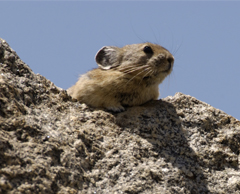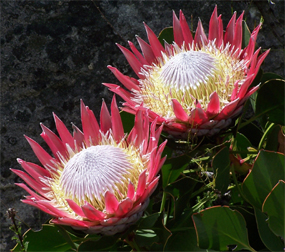 Climate change
is not a new phenomenon, nor is extinction. Many times in Earth’s history,
the climate has changed — sometimes rapidly and drastically — and
species have become extinct. At least five times, more than 50 percent of species
inhabiting the planet have died out, and as few as 2 to 4 percent of the species
that have ever lived are believed to survive today. Some scientists say that
in the face of impending climate change, the world may be headed into another
mass extinction event.
Climate change
is not a new phenomenon, nor is extinction. Many times in Earth’s history,
the climate has changed — sometimes rapidly and drastically — and
species have become extinct. At least five times, more than 50 percent of species
inhabiting the planet have died out, and as few as 2 to 4 percent of the species
that have ever lived are believed to survive today. Some scientists say that
in the face of impending climate change, the world may be headed into another
mass extinction event. As temperatures warm, the American pika, which lives on moist, cool mountaintops, such as Mount Evans in Colorado, shown here, does not have much room for upslope migration. Courtesy of Steven Morello.
“The difference today is that the world is inhabited by close to 7 billion people and biodiversity has been put into small refuges rather like islands,” said Richard Leakey, one of the world’s foremost anthropologists and wildlife ecologists, at the Stony Brook World Environmental Forum, which he convened last May on Long Island to discuss climate change and biodiversity. Scientists, he said, need to be talking now about what climate change is going to do to life as we have known it. Developing a better understanding of climate’s effects on various species, as well as better protecting and connecting the existing refuges, will help better prepare the world for any changes to come, meeting participants said.
In its Third Assessment Report, the Intergovernmental Panel on Climate Change (IPCC) estimated that Earth will warm by between 1.4 and 5.8 degrees Celsius by 2100. While humans may be able to adapt to warming at the low end of this range, other life forms might face more serious consequences; warming at the high end of the range could be catastrophic for all life on the planet, considering 5 to 7 degrees Celsius is the difference between an ice age and an interglacial period, says Stephen Schneider, a climatologist at Stanford University who has served on the IPCC.
Still, the climate change debate “is characterized by deep uncertainty,” Schneider says, noting that there will always be uncertainty about future events. Still, he says, if the IPCC projections are correct even on the lower end of the range, likely effects could include more frequent heat waves and less frequent cold spells; increased weather extremes, including drought and storms; loss of farming productivity; and rising sea levels and sea-surface temperatures. No place will be immune, he says, including areas set aside as protected habitats.
More than 1.9 million species have been cataloged on Earth, but scientists believe that at least 5 million to 30 million species exist, according to the World Conservation Union (IUCN). Over the past 500 years, human activity has forced 844 known species to extinction, and 15,589 known species are facing extinction right now. The current extinction rate, since A.D. 1500, is estimated to exceed the natural extinction rate by 100 to 1,000 times, IUCN says. And climate change will only exacerbate this rate as further stress is put on an already stressed system, says Lee Hannah, a climate change biologist at the Center for Applied Biodiversity Science with Conservation International.
 But just as
climate change will not affect the whole world equally, it will not affect all
species in the same way, Hannah says. The fossil record clearly shows, he says,
that species respond individually to climate change, not as coherent communities.
So although scientists are already seeing some of the changes to come, especially
in higher latitudes, such as birds migrating and breeding earlier in spring,
and fish moving to cooler waters farther north, it is important to conduct bioclimatic
modeling studies to “give us a better picture of what could happen,”
Hannah says.
But just as
climate change will not affect the whole world equally, it will not affect all
species in the same way, Hannah says. The fossil record clearly shows, he says,
that species respond individually to climate change, not as coherent communities.
So although scientists are already seeing some of the changes to come, especially
in higher latitudes, such as birds migrating and breeding earlier in spring,
and fish moving to cooler waters farther north, it is important to conduct bioclimatic
modeling studies to “give us a better picture of what could happen,”
Hannah says. Three hundred species of these exotic plants called proteas, which are endemic to the Cape Floristic Region of South Africa, stand a 21 to 40 percent chance of extinction if the climate warms as projected in mid-range estimates by the Intergovernmental Panel on Climate Change, according to new research in BioScience. Courtesy of Guy Midgley.
Not only warming temperatures pose problems, says Thure Cerling, a geologist at the University of Utah in Salt Lake City. The water balance will also change, causing trouble for species that depend on certain equilibriums of precipitation and evaporation. For example, the American pika, which depends on moist, cool mountaintop climates, is quickly facing extinction due to climate change. Because the small rodent-like mammals already live in tiny niches atop mountains, they do not have much room to move up-slope and they are not physiologically designed to migrate, according to the World Wildlife Fund (WWF). Although some species can migrate, such as the grizzly bear, species that depend on cooler temperatures, such as those that live in higher latitudes or altitudes such as pikas or polar bears, will be even more threatened because of less room for habitat expansion, Hannah says.
Climate change impacts are equally dramatic in the oceans, says Jane Lubchenco, a marine ecologist at Oregon State University in Corvallis. “We’re already seeing increased sea-surface temperatures, upwelling, more storms, increased acidification and circulation changes,” she says. Although scientists do not know enough yet about all the effects of these changes on marine organisms, Lubchenco says, they do know that corals, which cannot migrate, are bleaching and dying quickly, and fish that can migrate, such as tuna, are moving to cooler waters.
Climate change is a reality that at this point cannot be turned around, Hannah says. “But we don’t have to throw up our hands into the air” in exasperation, Cerling adds. “We don’t have to lose the rest of the megafauna we have on the planet. But we do have to do something now to protect it if we don’t want to lose it.”
A key step in that process is “resilience building,” says Lara Hansen, chief scientist of the Climate Change Program at WWF. Resilience building changes the way protected areas and resources are managed by considering not only what the ecosystems or habitats (and everything in the ecosystems) need right now, but also what they might need 20, 50 or 100 years from now. Part of what ecosystems need is more connectivity between protected areas — a way to change what are now postage-stamp-sized refuges surrounded by human activities to interconnected systems that give plants and animals more room in which to operate, she says.
About 12 percent of Earth’s land surface is protected, says Jeff McNeely, chief scientist at IUCN, while less than 1 percent of the ocean is protected, Lubchenco says. Merely setting aside land or ocean acreage, however, is insufficient, Lubchenco says — “it’s hugely important to pay attention to what’s happening around the reserve” as well as what’s happening inside.
As the climate changes, for example, threatened species may need to change locations to survive, McNeely says. Having spaces between and surrounding protected areas managed in ways that do not discourage species from spreading out would then become key, he says. Even better, would be to manage these in ways that actively encourage dispersal, for example, by creating national forests and building wildlife underpasses or corridors where highways cut through the habitat, such as has been done in the Los Angeles area, he says.
“Protected areas are great, but they won’t [preserve biodiversity] alone,” Hansen says. Countries also need to take active steps to reduce greenhouse gas emissions to curtail global warming, she says. Indeed, Hannah says, “we need to stop anything that is currently threatening ecosystems because climate change will only heighten the threats.” It is important to emphasize that extinctions estimated due to climate change are not inevitable, he says, “but if we can’t do the simple stuff like protecting parks now, we have little hope of addressing a complex threat like climate change later.”

